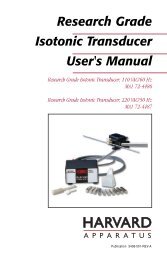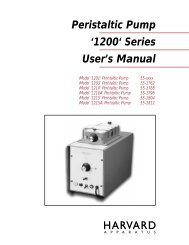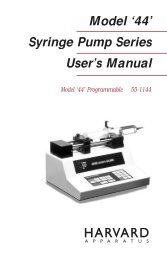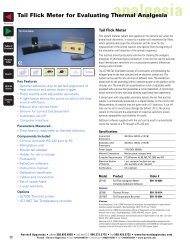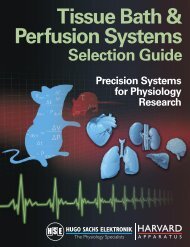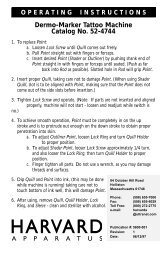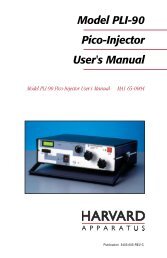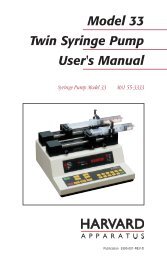View Catalog PDF - Harvard Apparatus
View Catalog PDF - Harvard Apparatus
View Catalog PDF - Harvard Apparatus
You also want an ePaper? Increase the reach of your titles
YUMPU automatically turns print PDFs into web optimized ePapers that Google loves.
Sensory Motor & Coordination Guide<br />
Behavioral Test<br />
Rotameter Test<br />
Rotational behavior has proved a popular<br />
technique for screening the behavioral effects<br />
of a wide variety of lesions, drugs, and other<br />
experimental manipulations on the brain of<br />
rodents. This test is widely carried out in<br />
experiments using animal models of Parkinson<br />
disease with unilateral lesions in the<br />
dopaminergic nigrostriatal system in which the<br />
number and direction of animal rotations in<br />
quantified after apormorphine treatment.<br />
Reasons for Choosing This Test<br />
➤<br />
➤<br />
Rapid and easy-to-do test<br />
Can be entirely automated<br />
Related Human Disease/Applications<br />
➤<br />
➤<br />
Drug Screening<br />
Parkinson’s Disease<br />
Behavioral Test<br />
Treadmill<br />
The Treadmill Test in rodents is a useful tool with<br />
a great value in the study of functional capacity. It<br />
is a validated standard model for investigations in<br />
the field of human metabolism. A subject is<br />
forced to walk/run on a treadmill (adjustable<br />
speed and inclination) during specific periods of<br />
time. This test allows the study of various<br />
physiological and behavioral functions such as<br />
long and short-term effort during exercise,<br />
locomotion, metabolic exchanges, cardiac<br />
function, motor coordination and fatigue.<br />
Reasons for Choosing This Test<br />
➤ Adapted from a human test<br />
➤ Allows the researcher to precisely control the level<br />
of exertion<br />
➤ Easy to use, even for inexperienced users<br />
➤ Sensitive for mice and rats<br />
Reasons for Not Choosing This Test<br />
Behavioral Test<br />
Activity Wheel<br />
The Rodent Activity Wheel represents a very<br />
simple and clever way to register animal physical<br />
activity in its home cage environment. The use<br />
of this high throughput tool is particularly<br />
relevant for research involving circadian<br />
rhythms, phenotyping and drug testing. The time<br />
and distance run on a voluntary running wheel<br />
are monitored over several days or weeks to<br />
determine whether a particular substance or<br />
experimental manipulation has an effect on<br />
exercise behavior.<br />
Reasons for Choosing This Test<br />
➤<br />
➤<br />
➤<br />
➤<br />
➤<br />
➤<br />
Rodent voluntary exercise registering; allows<br />
animals to exercise when and at the intensity that<br />
they choose<br />
Accessibility to running wheel may reduce the<br />
effects of chronic stress on depression-like signs<br />
in mice<br />
Less labor intensive than treadmill running as<br />
researchers need not to be present during wheel<br />
running<br />
Relatively inexpensive setup<br />
Ideal for high throughput experiments; many animals<br />
can be trained at the same time<br />
Sensitive for both mice and rats<br />
Reasons for Not Choosing This Test<br />
➤<br />
➤<br />
➤<br />
Intensity and duration of the exercise cannot be<br />
controlled<br />
Certain lines of transgenic mice may not engage in<br />
enough voluntary wheel running exercise to produce<br />
training adaptations<br />
Not suitable for studies that require precise timing to<br />
explore acute post exercise adaptations (intermittent<br />
running throughout the active cycle)<br />
Related Human Disease/Applications<br />
➤ Drug Screening<br />
‰ Phenotyping<br />
‰ Neuromuscular Disease<br />
‰ Parkinson’s Disease<br />
‰ Muscular Dystrophy<br />
➤<br />
➤<br />
➤<br />
Needs repetitive daily exposure<br />
lasting several weeks<br />
Requires constant vigilance by<br />
the researcher to make sure that<br />
the animals run for the entire<br />
exercise test time<br />
Use of aversive stimuli to<br />
encourage running<br />
Related Human Disease/Applications<br />
➤ Improvement of sportive human performances<br />
➤ Oxidative Stress<br />
➤ Diabetes<br />
➤ Parkinsons’s Disease<br />
➤ Ischemia<br />
➤ Ostopenia/Osteoporosis<br />
21





